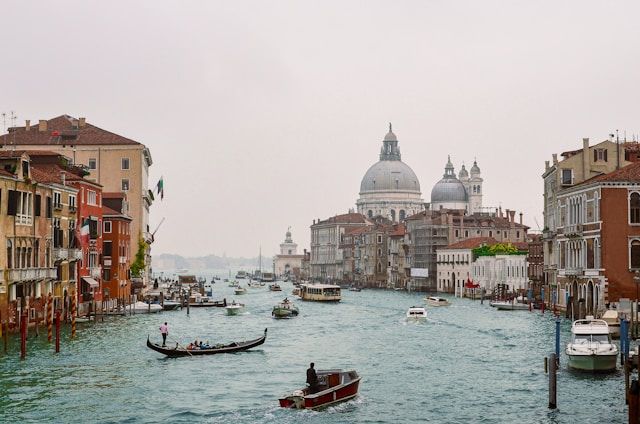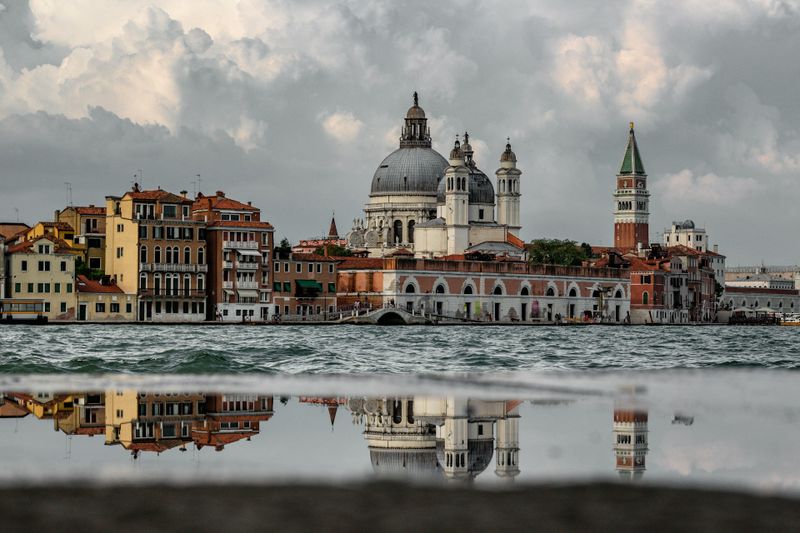When people think of Venice, they think of gondolas gliding through the canals in the warm Italian sun.
But for those who have been here during high water Venice wet autumn, there’s another side to this beautiful city: when the streets become canals, piazza san marco becomes a mirror, and locals and tourists alike wear their wellies as they explore the sinking city.
Venice, the floating city, becomes a whole different place in autumn. The dramatic rise of the water levels during this time brings challenges but also reveals a Venice like no other.
If you’re coming to Venice in 2024 autumn, here’s everything you need to know about high water Venice wet autumn and how it will affect your trip.
High water Venice wet autumn 2024

As autumn comes, so do the high waters in Venice, a natural but increasingly unpredictable event, largely caused by climate change.
The period from late September to December is the peak of Venice’s high water season, when the tides from the adriatic sea push into the venetian lagoon, flooding the streets and lowest parts of the city. This autumn there will be exceptional tides again, and high water in the city, a cruel reminder of its fragile relationship with the sea.
But while high waters in Venice might seem like a hassle to some, they’re also part of the city’s DNA. Venice has always been a city of the tides, and these autumn floods bring an authenticity and atmosphere that summer crowds can only dream of.
Wandering through the flooded streets, watching the city centre reflect the shimmering lights of piazza san marco — it’s a feeling that stays with you.
Why high water Venice wet autumn?
So why does high water Venice wet autumn happen? The answer is a combination of natural and human factors. Venice is a city in a lagoon, and its proximity to the adriatic sea makes it more prone to high tides. During autumn, this is further complicated by:
- Astronomical tides: The moon’s gravitational pull is stronger during the winter months, so the tides are higher than usual.
- Strong south wind: The scirocco, a warm wind from North Africa, pushes water from the adriatic sea into the venetian lagoon, flooding the lowest parts of Venice.
- Rising sea levels: Global sea levels are rising due to climate change, so these seasonal floods are more frequent and more severe.
In short, Venice’s position and the climate change mean that high waters are now part of the city’s scenery. For those visiting during wet autumn, you’ll need to be prepared for wet feet but it’s also a unique chance to see Venice as it really is.
Which months does Venice flood the most?
Venice’s flooding season starts in late September and goes through the winter, with the highest probability of flooding in October, November and December. These months have the most frequent high tides, November being the most intense, when autumn rains, astronomical tides and winds from the open sea make the water rise in Venice.
In November 2024, as in previous years, Venice will have several exceptional tides, when the water will reach over 140cm. During these periods the whole city can flood, including piazza san marco, which is one of the lowest points of the city.
Does Venice flood in early october?
Yes, Venice floods in October but the frequency and height of the high tides increase as the season goes on. Early October is the first high waters of the autumn and can catch visitors by surprise. If you’re planning to visit during this time, bring a pair of plastic booties or rubber boots to avoid wet feet.
Flooding in October is not as extreme as in November or December but Venice’s lowest parts can still flood, especially in san marco and the grand canal.
How do i check if Venice is flooded?
Visitors to Venice can check the water levels by following the local weather forecast and tide predictions. The city’s tide monitoring system sends regular updates on the high tides so both locals and tourists can plan their day.
The Venice City Council also has a tide monitoring system via text alerts and apps that sends real time updates on potential floods. And the punta della salute tide gauge station has the water levels online.
When was the last "Acqua Alta" in Venice?
The last significant acqua alta in Venice was in late August 2024, an unprecedented event for that time of year. Normally these high waters are in the cold months but climate change is making Venice’s water levels unpredictable. In the summer 2024 Venice had 23 times the tides over 80cm, an unheard of event according to CNR and the Venice Municipality’s Tides Center.
This summer flooding shows how the acqua alta is becoming more and more unpredictable so it’s even more important to be informed.
Acqua Alta Venice: The rising waters
Acqua alta is the term for the exceptional high tides that flood Venice. These tides happen when a combination of meteorological and astronomical factors make the water level rise above normal.
While many parts of Venice are designed to withstand small floods, acqua alta can sometimes overwhelm the city, especially when an exceptional tide occurs. During these events the water can rise up to 160cm and streets become canals and residents and tourists have to wade through the flooded streets.
Venice is trying to combat the flooding with the MOSE system, a series of mobile barriers that can be raised to block the adriatic sea from entering the venetian lagoon. But the system is only activated for floods above 110cm so high waters below this level still flood parts of the city.
Piazza San Marco: Venice’s lowest point
As the lowest point in Venice, piazza san marco is the first to flood during high tides. This iconic square, famous for its architecture and landmarks, becomes a huge mirror reflecting the sky during high water. The flooded piazza has become a symbol of Venice’s vulnerability to the rising waters but also of its resilience.
For visitors it’s a unique experience to see mark’s square underwater several inches of water, a surreal landscape perfect for photography — if you have dry feet! Just be prepared to wade through the wet streets or use the raised walkways that are set up in the city centre.
High Tide: When Venice rises
High tide is the main cause of the flooding in Venice. The high tides from the adriatic sea push into the venetian lagoon, raising the water level and flooding the streets. These tides happen most often in the fall and winter when the winds and the astronomical tides push the water into the lagoon.
Venice has learned to live with these high tides over the centuries. Many buildings have entrances that can be closed to the water and the locals are experts in navigating the flooded streets.
The future of Venice’s high waters
As climate change is accelerating Venice’s high waters are becoming more frequent and unpredictable. The sinking city has an uncertain future as the sea levels will continue to rise and even the MOSE system may not be able to save the city.
For now Venice is still here, a city where even the floods are part of the charm. As you plan your visit during the high water Venice wet autumn 2024 wear your rubber boots, check the tides and enjoy the adventure.

